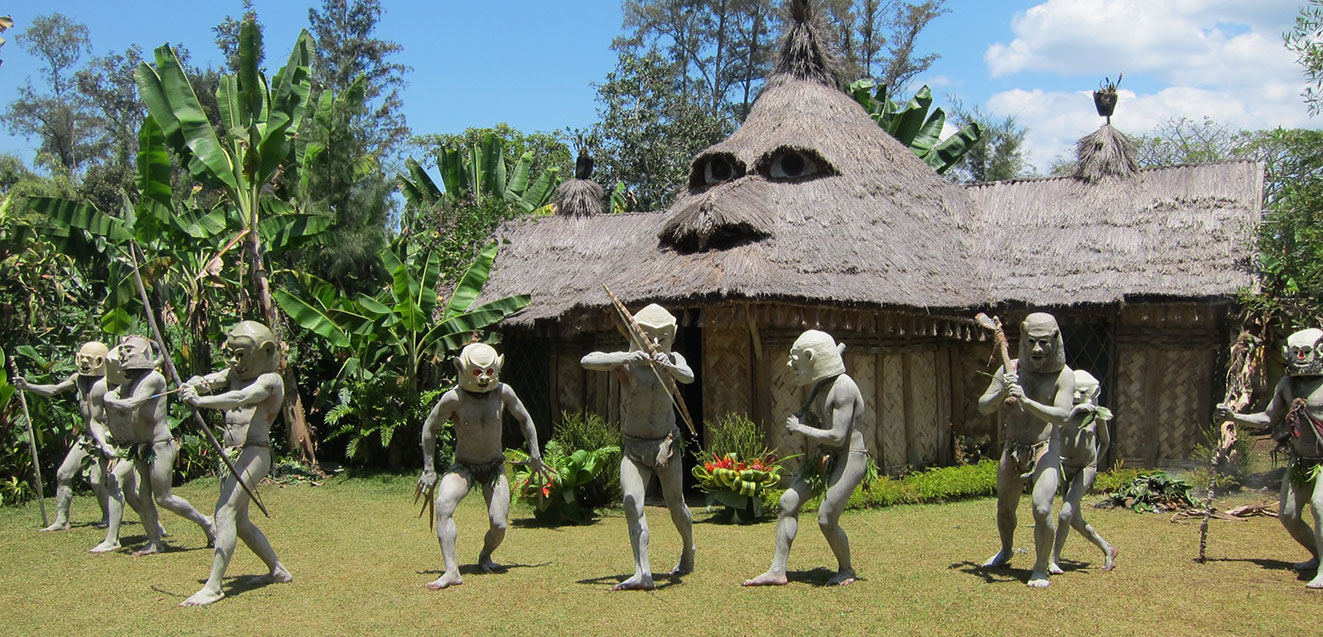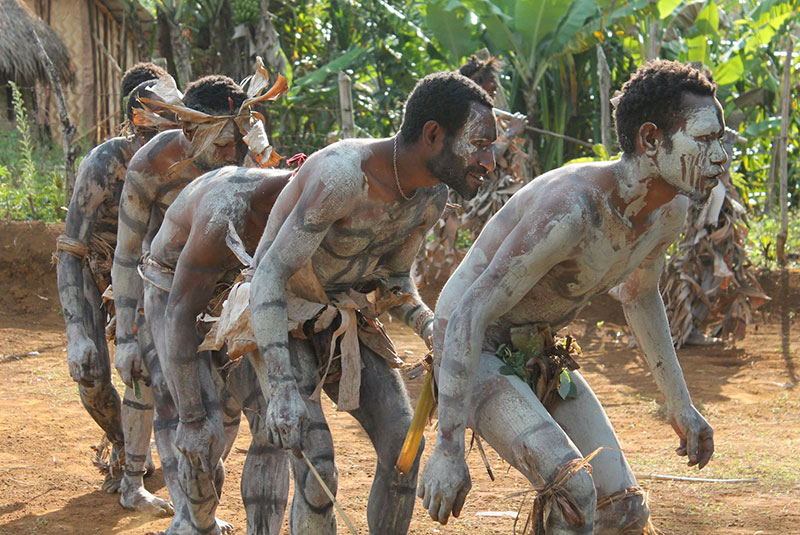Ghosts of Papua New Guinea

They emerge from the jungle like a slow, incoming tide, their movements an almost imperceptible dance. Their gray-coated bodies and oversized fright masks shock and intimidate. One man will appear briefly at the jungle’s edge, then disappear. Was he really there? Distracted, the visitor is suddenly surrounded by ethereal spirits. They are the Asaro Mud Men, and they are at once among Papua New Guinea’s poorest people and its rock stars.
While most of the 150-plus tribes on the island are as colorful as the exotic birds with which they share the jungle, the Mud Men are the least adorned. When they appear, smeared neck to toe with white clay, they keep to a single file, walking glacially slow, every tendon of their whippet-like bodies taut as their bowstrings, constantly looking left, right, behind, ready for anything. Some have arrows nocked in their bows while others have spears and clubs. Some wear red-painted bamboo on their fingers, extending for several inches and filed to a razor point, like giant claws. There is no talking; even those watching them are silent.
The Mud Men have been highly romanticized in literature, often as the noble savage, but they are quite simply connected to the earth in the most basic way. While many tribal people use smeared mud to go to war, the Asaro tribe wears it to avoid battle. Their prowess as warriors has always been inflated, and although literature and legend have ascribed them special martial powers, their only real advantage in a battle is their fiercely scary appearance. If you can generate fear, you do not have to go to war.

The Asaro, also known as the Holosa (which translates literally as “ghosts”), range throughout the area of Goroka, in Papua New Guinea’s Eastern Highlands. The village I visited sat on a wind-blown, dust-filled plain, populated by a few woven bamboo huts and one brand new aluminum home for the local government official. The large communal square was packed earth from centuries of dancing feet, while the concrete vault that held the remains of “the ultimate chief,” lay under a twisted tin roof that looked like a Winnebago had just pulled out of its stall. It was the kind of place safari buses unwittingly pass by, only learning later that they just missed the island’s most famous inhabitants.
It was in Goroka that I met Kowa, his body coated with gray clay from a ceremony. It was my great fortune to meet this artist because he alone is the current maker of the Asaro’s famous mud masks.

When I met Kowa, he was squatting on the ground, flattening moist clay balls and rolling them into long, thin, sausage-like sections. I thought this was probably some sort of secret ceremony and was surprised by his willingness to share such an intimate act with me, but Kowa was proud to show his art and its process. He worked with the hands of a sculptor, hands that read clay like most people read a book. He was the purest kind of artist, one with his medium, and as he worked he began to relate his tribal history to me.
Some two centuries ago, the Asaro were shy, retiring jungle-dwellers. One day they were attacked by a much more powerful tribe and fled into the nearby Asaro River. When their assailants reached the river, they came upon figures coated in white and gray river mud. Believing they had encountered the ghost spirits of the Asaro they had killed, the aggressors fled in confused panic.
Realizing what had happened, the Asaro decided to retaliate. They coated their bodies with mud, but not their faces, as they believed the water of the Asaro River to be poisonous. Instead, they used rocks, sticks, and whatever they could find to create simple masks. When they appeared in this form, their former enemies fled and the peace-loving Asaro inherited the reputation of fierce warriors.

Kowa paused. Then he looked up slightly towards me and said, “That is the story we tell tourists, but I think you are looking for something more.”
I sat down to listen. Kowa told me that the Asaro has a chairman—rather than a chief—and that in the late 19th century, the distant grandfather of the current chairman had relocated from one area in the highlands to another. This is where he first learned the practice of bakime: using a disguise to take revenge on an enemy.
He said the people there would cover their faces with a white sap from a local tree as a disguise. When the elderly grandfather finally returned home, he refined bakime by introducing what he called girituwai: using a light wooden frame with a bag covering it. Eye holes were cut and the finished piece, which engulfed the entire head, was then smeared with mud. The masks, proving to be scarier than a face full of tree sap, caught on and spread in various forms across the highlands.
Spearing raids to capture pigs and women were common until the mid-20th century. In an effort to curb this cultural violence, in 1957 local organizers put on what was called the “First Eastern Highlands Agricultural Show,” and they invited the Asaro to participate. The tribal chairman at that time, Ruipo Okoroho, saw an opportunity to put the Mud Men on the tourist map. Organizing all of the local headmen, he had them wear, for the first time, the prototypes of today’s Papua New Guinea masks, large, surreal, and weighty. The story goes that the day of the first “Sing-Sing,” as the show is popularly called, over 200 masked Mud Men stalked slowly onto the grounds, driving a screaming and terrified audience before them. No one had seen anything like them, especially not in such numbers. The Mud Men took first prize for tribal representation that year and the following two years, prompting an end to all such competitions in the future. Today, 62 years later, the annual “Sing-Sing” is a world-renowned festival three days long, and the Mud Men are still its rock stars.
Kowa told me his ancestor made the first true mud mask and the honor has been passed down through generations, but only on the male side as there are no mud women. In a few years, Kowa’s son would take his place.
No two Papua New Guinea masks are alike: Each springs from the imagination of its maker. They might have horns or tusks, ears or a gigantic nose, be partially painted, or have messages etched inside. The original intent was always to strike fear into one’s opponent. They are sun-dried rather than baked, and the process takes many days. The end result is surprisingly heavy. Weighing upwards of 20-25 pounds and sitting directly on the wearer’s collarbone, they take a toll. After a ceremony, the Mud Men are bathed in sweat. When I tried to put a mask on, it took several different ones before my Western-sized nose could be accommodated without crushing it. Kowa said no padding could be used as it would “not be real.”
Sitting with Kowa as he worked, I was taken by his cat-like grace. His movements were almost feminine, and it struck me that I was watching a ballet. Even though Kowa spoke with me while he worked, I could tell he was in another place. I felt his ancestors were guiding his hands.

The Asaro do not dance in the traditional sense but they are marvelous storytellers who mime their tales in elaborate charades. They paint their bodies according to each story being told, and I was witness to one story about negotiating the price for a bride (usually two pigs and a young cassowary). Another told of fighting off a forest spirit trying to kidnap a child, and a final one dealt with the cannibalism of their ancient past. Each ceremony was a village effort with those not on view helping behind the scenes with costumes and body paint. Their stories were acted out in the same slow motion as their patented stalking walk.
Light fades quickly in the Goroka highlands, and as shadows crept over us, Kowa said it was his ancestors telling us it was time to leave. I was so engrossed in our conversation that I had forgotten to watch the tiny mud mask he had been making all the while. He placed it in my hand and said simply, “Remember us.” I felt as though Picasso had handed me a signed sketch.
Today the Mud Men are one of the most recognizable tribal cultures in existence. Their mystique continues to spread and it is to their credit that they have maintained this hereditary image of being fierce warriors while they are in fact among the friendliest people alive. It is because they cling to the old ways that they have become the symbol of their nation. The world has watched them drink orange soda on Australian television, sell perfume on European TV, and appear in print ads for a well-known 4X4 vehicle. Their image has graced two musical albums and the rock band Pink Floyd wrote a song called “Mud Men” that was used in the film “La Vallee,” by Barbet Schroeder, which featured the Mud Men.
Last year’s Sing-Sing brought together over 150,000 tribal participants, and even neighboring tribes crowded around to see the Mud Men.
Today, my little Mud Man sits grimacing at me on my desk. He is a reminder that sometimes travel takes us to unknown realms, and gifts us with unexpected lessons.
# # # # #
I love PNG

